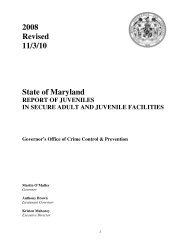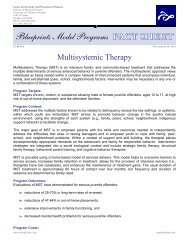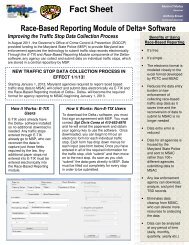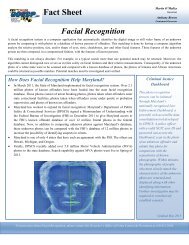Targeted Outreach - Governor's Office of Crime Control & Prevention ...
Targeted Outreach - Governor's Office of Crime Control & Prevention ...
Targeted Outreach - Governor's Office of Crime Control & Prevention ...
You also want an ePaper? Increase the reach of your titles
YUMPU automatically turns print PDFs into web optimized ePapers that Google loves.
iv<br />
<strong>Targeted</strong> <strong>Outreach</strong><br />
Girls Club staff member (with 79 percent and 53 percent,<br />
respectively, reporting that there are two or<br />
more Boys & Girls Club staff from whom they<br />
received support). A majority <strong>of</strong> youth agreed or<br />
strongly agreed that they felt a sense <strong>of</strong> belonging to<br />
the Club (64 percent <strong>of</strong> prevention and 56 percent<br />
<strong>of</strong> intervention). Fifty-nine percent <strong>of</strong> prevention target<br />
youth and 35 percent <strong>of</strong> intervention target<br />
youth reported that the Club activities are interesting<br />
and challenging.<br />
Most target youth also perceived the Club as “safe.”<br />
On a scale <strong>of</strong> 1 to 10, with 10 being safest, 86 percent<br />
<strong>of</strong> prevention and 70 percent <strong>of</strong> intervention youth<br />
rated the Club at 8 or higher. In contrast, only 64<br />
percent <strong>of</strong> prevention and 43 percent <strong>of</strong> intervention<br />
youth rated their schools as this safe. These experiences,<br />
which are critical to successful youth development,<br />
provide opportunities that these youth may<br />
not have received in other realms <strong>of</strong> their lives.<br />
Without the Club, they may have sought similar<br />
experiences through gang involvement.<br />
Did youth’s participation in the Clubs play a<br />
positive role in and have the desired effects on<br />
their lives—keeping them away from gangs and<br />
delinquency and increasing their positive school<br />
behaviors and success?<br />
More frequent GPTTO Club attendance is associated<br />
with the following positive outcomes: 4<br />
• Delayed onset <strong>of</strong> one gang behavior (less likely<br />
to start wearing gang colors*),<br />
• Less contact with the juvenile justice system<br />
(less likely to be sent away by the court+),<br />
• Fewer delinquent behaviors (stealing less+, and<br />
less likely to start smoking pot+),<br />
• Improved school outcomes (higher grades+ and<br />
greater valuing <strong>of</strong> doing well in school+), and<br />
• More positive social relationships and productive<br />
use <strong>of</strong> out-or-school time (engaging in more<br />
positive after-school activities+ and increased levels<br />
<strong>of</strong> positive peer* and family relationships*).<br />
More frequent attendance among GITTO youth is<br />
associated with the following positive outcomes:<br />
• Disengagement from gang-associated behaviors<br />
and peers (less stealing with gang members*,<br />
wearing gang colors+, flashing gang signals***,<br />
hanging out at the same place as gang members*,<br />
being a victim <strong>of</strong> a gang attack+ and having<br />
fewer negative peers+),<br />
• Less contact with the juvenile justice system (a<br />
lower incidence <strong>of</strong> being sent away by the<br />
court**), and<br />
• More positive school engagement (greater<br />
expectations <strong>of</strong> graduating from high school or<br />
receiving a GED*).<br />
How did Clubs accomplish their GPTTO and<br />
GITTO goals, and what challenges did they face?<br />
Although each Club implemented the components<br />
<strong>of</strong> GPTTO or GITTO differently, they experienced<br />
some consistent operational challenges. Interestingly,<br />
although program evaluations <strong>of</strong>ten uncover substantive<br />
programmatic challenges, the main challenges<br />
that the clubs implementing GPTTO and GITTO<br />
faced were administrative. Below, we highlight the<br />
Clubs’ main operational challenges.<br />
Club staff felt challenged to keep up with the<br />
influx <strong>of</strong> new staff at collaborating agencies.<br />
Collaborating agencies suggested that Clubs’ staff<br />
increase their follow-up, specifically by holding multiple<br />
orientations for additional or new agency<br />
employees and updating the referring agency about<br />
the status <strong>of</strong> the referred youth. Such contacts, the<br />
agencies felt, would help to maximize referrals and<br />
improve the collaborative relationship.<br />
The Case Management documentation component<br />
brought some specific challenges.<br />
All Clubs were most consistent at tracking youth’s<br />
progress, behaviors and achievements at the Clubs.<br />
There was greater variation in their ability to document<br />
their progress at school, within the juvenile<br />
justice system or at home. Clubs that forged relationships<br />
with schools more consistently gathered and<br />
documented the school information. Those that had<br />
a relationship with police and probation followed<br />
youth’s progress in juvenile justice more consistently.<br />
When Clubs were not able to maintain relationships<br />
with schools, probation or police, they could not<br />
monitor youth’s progress in those areas. Additionally,<br />
Clubs found the lengthy paperwork burdensome.<br />
Although monthly tracking forms are components <strong>of</strong><br />
the GPTTO and GITTO documentation philosophy,<br />
the evaluation required that Clubs provide the information<br />
at a level <strong>of</strong> specificity that the Clubs found

















